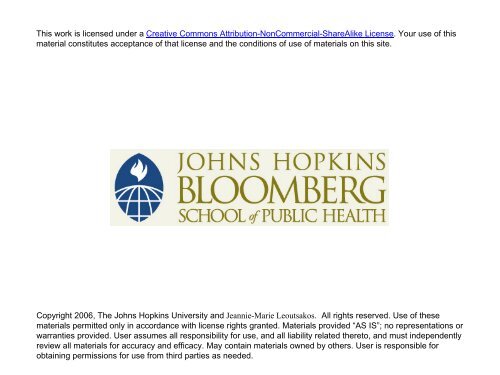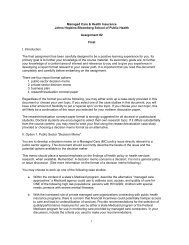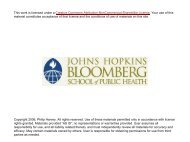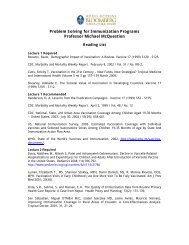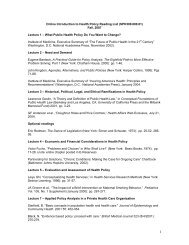Lecture 4: Principles of Psychometrics: Reliability II - jhsph ocw
Lecture 4: Principles of Psychometrics: Reliability II - jhsph ocw
Lecture 4: Principles of Psychometrics: Reliability II - jhsph ocw
Create successful ePaper yourself
Turn your PDF publications into a flip-book with our unique Google optimized e-Paper software.
This work is licensed under a Creative Commons Attribution-NonCommercial-ShareAlike License. Your use <strong>of</strong> this<br />
material constitutes acceptance <strong>of</strong> that license and the conditions <strong>of</strong> use <strong>of</strong> materials on this site.<br />
Copyright 2006, The Johns Hopkins University and Jeannie-Marie Leoutsakos. All rights reserved. Use <strong>of</strong> these<br />
materials permitted only in accordance with license rights granted. Materials provided “AS IS”; no representations or<br />
warranties provided. User assumes all responsibility for use, and all liability related thereto, and must independently<br />
review all materials for accuracy and efficacy. May contain materials owned by others. User is responsible for<br />
obtaining permissions for use from third parties as needed.
Statistics in Psychosocial Research<br />
<strong>Lecture</strong> 4<br />
<strong>Reliability</strong> <strong>II</strong><br />
<strong>Lecture</strong>r: Jeannie-Marie Leoutsakos
• Review <strong>of</strong> ANOVA<br />
Outline<br />
• Intra-Class Correlations<br />
• <strong>Reliability</strong> Examples<br />
• Other Research Designs
score<br />
-3 0 3 6 9 12 15<br />
1 2 3<br />
group
Are the true means for each group different from each other?<br />
score1<br />
-80 -60 -40 -20 0 20 40 60 80 100<br />
1 2 3<br />
group<br />
Compare amounts <strong>of</strong> variance within & between groups
i=1…,I indexes groups, j=1,…n i indexes members <strong>of</strong> group<br />
Source <strong>of</strong><br />
Variation<br />
Between<br />
Group<br />
Within<br />
Group<br />
I<br />
DF Sum <strong>of</strong> Squares<br />
(SS)<br />
−1<br />
N −<br />
I<br />
∑ ni ( Yi<br />
−Y<br />
∑ ∑ ( Yij<br />
−<br />
2<br />
)<br />
Y<br />
i j i<br />
2<br />
)<br />
Mean Square<br />
(MS)<br />
MSB =<br />
MSW =<br />
SSB<br />
DF<br />
SSW<br />
DF<br />
F-Ratio<br />
MSB<br />
MSW
. oneway score1 group<br />
Analysis <strong>of</strong> Variance<br />
Source SS df MS F Prob > F<br />
------------------------------------------------------------------------<br />
Between groups 4054.76741 2 2027.38371 2030.92 0.0000<br />
Within groups 1494.39042 1497 .998256793<br />
------------------------------------------------------------------------<br />
Total 5549.15783 1499 3.70190649
-80 -60 -40 -20 0 20 40 60 80 100<br />
1 2 3<br />
group<br />
score1 score2
. oneway score13 group<br />
Analysis <strong>of</strong> Variance<br />
Source SS df MS F Prob > F<br />
------------------------------------------------------------------------<br />
Between groups 4145.64545 2 2072.82273 2.42 0.0891<br />
Within groups 1281245.47 1497 855.8754<br />
------------------------------------------------------------------------<br />
Total 1285391.12 1499 857.499079
Intraclass correlation: Assessing<br />
inter-rater reliability<br />
• As before, reliability defined as:<br />
variance in true scores ⁄ variance in observed scores<br />
• For the intra-class correlation the specific form <strong>of</strong> this<br />
equation can take on at least six different forms<br />
• The correct form to use depends on the study design and<br />
the researcher’s assumptions about the patients and<br />
subjects (or items)<br />
• I will discuss three designs, each with two ICCs
Overview<br />
• Unique Design: Each <strong>of</strong> the I subjects rated by a unique<br />
set <strong>of</strong> m raters (m>1), such that the total number <strong>of</strong><br />
raters, R, is m*I<br />
• Fixed Design: Each subject is rated by each <strong>of</strong> the same<br />
m raters, such that the total number <strong>of</strong> raters, R is m.<br />
These raters are the only raters <strong>of</strong> interest.<br />
• Random Design: m raters are drawn from a larger pool<br />
<strong>of</strong> raters. Each <strong>of</strong> the I subjects is rated by each <strong>of</strong> the m<br />
raters. Again, the total number <strong>of</strong> raters, R is m.<br />
NOTE: raters might be people or questionnaire items
• No Overlap <strong>of</strong> Raters<br />
Unique Design<br />
rater 1 rater 2 rater 3 rater 4 rater 5 rater 6<br />
s 1 s 2 s 3<br />
• m=2, I=3 # <strong>of</strong> raters=m*I=6
Fixed Design<br />
• Total Overlap <strong>of</strong> Raters<br />
rater 1<br />
rater 2<br />
rater 3<br />
s 1 s 2 s 3<br />
• m=3, n=3 # <strong>of</strong> raters=m=3
Random Design<br />
• Total Overlap <strong>of</strong> Raters, but raters drawn from a<br />
pool.<br />
rater 1<br />
Pool <strong>of</strong> Raters<br />
rater 2<br />
rater 3<br />
s 1 s 2 s 3
Types <strong>of</strong> <strong>Reliability</strong><br />
• There are two (at least) types <strong>of</strong> reliability<br />
associated with each <strong>of</strong> these designs.<br />
– <strong>Reliability</strong> <strong>of</strong> mean ratings: reliability <strong>of</strong><br />
average <strong>of</strong> all ratings per subject<br />
– <strong>Reliability</strong> <strong>of</strong> one individual rating: reliability<br />
<strong>of</strong> a single rating <strong>of</strong> one subject<br />
• Which will be higher?<br />
•Why?
2 4 6 8 10<br />
0 2 4 6 8 10<br />
ta<br />
1 score 2 score<br />
3 score meanscore
Unique Rater Design ICC<br />
Equation to estimate reliability <strong>of</strong> rating means<br />
Between Mean Square Variance – Within Mean Square Variance<br />
Between Mean Square Variance<br />
MSB – MSW<br />
MSB
Between Mean Score Variance (Each TA is a group): Observed mean<br />
variance<br />
meanscore<br />
2 4 6 8 10<br />
0 2 4 6 8 10<br />
ta
Between Mean Score Variance<br />
Degree to which mean score <strong>of</strong> rated subjects differ from grand mean<br />
1<br />
s<br />
2<br />
− ≅ σ<br />
b<br />
i<br />
−<br />
= ∑ I 1 i = 1<br />
I<br />
( ) ( ) m Y Y<br />
2<br />
• I = number <strong>of</strong> people being rated (# <strong>of</strong> TAs)<br />
• Y = mean score for each TA rated<br />
i<br />
• Y<br />
= overall mean <strong>of</strong> scores for whole sample<br />
• m = number <strong>of</strong> raters for each mean<br />
2<br />
b
Unique Rater Design<br />
1) Between Mean Score Variance, steps in Stata<br />
a) calculate mean scores for each individual<br />
*e.g. egen meanta = rmean(score1 score2 score3)<br />
b) calculate overall mean<br />
*e.g. egen grandmean = mean(meanta)<br />
c) calculate deviation <strong>of</strong> individual mean from group mean<br />
*e.g. gen bsquarei = 3*(meanta-grandmean)^2<br />
d) add up all deviations in (c)<br />
*e.g. egen bsquare = sum(bsquarei)<br />
e) divide sum <strong>of</strong> squares by degrees <strong>of</strong> freedom<br />
*e.g. display bsquare/(10-1) =
Unique Rater Design (cont’d)<br />
2) Within Mean Score Variance: Degree to which individual<br />
scores differ from a subject’s mean score<br />
2<br />
1 I m<br />
2<br />
= ∑ ∑ Y Y<br />
w ( 1)<br />
ij i<br />
I m i = 1 j = 1<br />
( ) 2<br />
s − ≅ σ<br />
−<br />
Where:<br />
• I = number <strong>of</strong> individuals being rated (# <strong>of</strong> TAs)<br />
• R = number <strong>of</strong> raters<br />
•Yij = score <strong>of</strong> each individual rater<br />
Y<br />
• = mean score <strong>of</strong> each person rated<br />
i<br />
• m = number <strong>of</strong> raters for each mean<br />
Note: R=m<br />
w
Unique Rater Design<br />
3) Within Mean Score Variance, steps in Stata<br />
a) calculate mean scores for each individual<br />
*e.g. egen meanid = rmean(score1 score2 score3)<br />
b) calculate deviation <strong>of</strong> rater from individual mean<br />
*e.g. gen wsquarei = (score1-meanid)^2 + (score2-meanid)^2<br />
+ (score3- meanid)^2<br />
c) add up deviations in (b) across all individuals<br />
*e.g. egen wsquare =sum(wsquarei)<br />
d) divide sum <strong>of</strong> squares by degrees <strong>of</strong> freedom<br />
*e.g. display wsquare/I*(m-1) =
Unique Rater Design<br />
Shortcut: Use procedure ‘oneway’ in Stata<br />
First, must “reshape” data.<br />
. reshape long score, i(ta) j(rater)
Using ANOVA in STATA to<br />
Example:<br />
. oneway score ta<br />
Calculate Variance<br />
Analysis <strong>of</strong> Variance<br />
Source SS df MS<br />
------------------------------------------------------<br />
Between groups 114.00 9 12.6666667<br />
Within groups 30.00 20 1.50<br />
------------------------------------------------------<br />
Total 144.00 29 4.96551724<br />
ICC<br />
MSB − MSW<br />
MSB<br />
12.<br />
67 −1.<br />
50<br />
= ICC<br />
=<br />
= . 8816<br />
12.<br />
67
Important Note<br />
1. <strong>Reliability</strong> is a group-specific statistic.<br />
2. The greater the variance in the true scores <strong>of</strong> a population, the<br />
higher the reliability <strong>of</strong> the measure (if observed variance is<br />
constant)<br />
<strong>Reliability</strong> =<br />
Variance in true scores<br />
Variance in observed scores
<strong>Reliability</strong> for Individual Ratings<br />
So far we’ve calculated reliability <strong>of</strong> the mean score for each TA.<br />
What is the average reliability <strong>of</strong> each individual rating <strong>of</strong> the TA?
<strong>Reliability</strong> <strong>of</strong> Individual Scores in<br />
Unique Rater Design<br />
MSB − MSW<br />
MSB + ( m −1)<br />
MSW<br />
Where m = number <strong>of</strong> raters per TA<br />
Continuing with our example:<br />
( 12.<br />
67 −1.<br />
50)<br />
Re liability<br />
=<br />
=<br />
12.<br />
67 + ( 3−1)<br />
* 1.<br />
50<br />
. 7128
Fixed Rater Design<br />
1) Each subject rated by each <strong>of</strong> the same m raters, who are the<br />
only raters <strong>of</strong> interest<br />
2) examples:<br />
3) Computation involves two-way analysis <strong>of</strong> variance<br />
4) Before: two sources <strong>of</strong> error, (differences across individuals,<br />
and error inherent to the measurement) Error now only has one<br />
source: error due to individuals is ‘controlled.’
Fixed Rater Design<br />
Recall that the equation for Unique Rater Design was:<br />
MSB – MSW<br />
MSB<br />
Which can also be expressed as:<br />
MSB– (MSRater + MSE)<br />
MSB<br />
The equation for the fixed rater design is very similar:<br />
MSB– (MSE)<br />
MSB
2 4 6 8 10<br />
0 2 4 6 8 10<br />
ta<br />
1 score 2 score<br />
3 score meanscore
5 5.5 6 6.5 7<br />
Rater Mean Variance<br />
1 1.5 2 2.5 3<br />
rater<br />
mean1 mean2<br />
mean3
Fixed Rater Design<br />
Rater Mean Score Variance: Degree to which raters’<br />
mean scores differ from those <strong>of</strong> the overall mean<br />
1<br />
s<br />
2<br />
− ≅ σ<br />
r<br />
−<br />
Where:<br />
m<br />
= ∑<br />
j = 1<br />
( ) ( ) ( ) I Y Y<br />
2<br />
j<br />
r<br />
m 1<br />
• m = number <strong>of</strong> raters (in fixed design, R=m)<br />
• I = number <strong>of</strong> subjects evaluated (# <strong>of</strong> TAs)<br />
• Yj<br />
= mean score <strong>of</strong> rater<br />
• Y = overall mean score for sample<br />
2
Steps in Stata<br />
1. Calculate overall mean<br />
Fixed Rater Design<br />
2. Calculate mean for each rater<br />
*e.g. egen r1mean=mean(rater1)<br />
egen r2mean=mean(rater2)…<br />
3. Calculate deviation <strong>of</strong> rater mean from<br />
overall mean<br />
*e.g. display N*(r1mean-grandmean)^2 +<br />
N*(r2mean-grandmean)^2…<br />
4. Calculate error square variance<br />
*error square variance = (within square variance – rater<br />
square variance)<br />
*divide by difference in degrees <strong>of</strong> freedom to get<br />
error variance
Example:<br />
Using ANOVA in STATA to<br />
. anova score ta Rater<br />
Calculate Variance<br />
Source | Partial SS df MS<br />
---------+--------------------------------<br />
Model | 134.00 11 12.1818182<br />
ta | 114.00 9 12.6666667<br />
Rater | 20.00 2 10.00<br />
Residual | 10.00 18 .555555556<br />
-----------+------------------------------<br />
Total | 144.00 29 4.96551724<br />
ICC for Fixed Rater Design, Group mean =<br />
MSB<br />
− MSE<br />
MSB<br />
=<br />
12.<br />
67<br />
−<br />
12.<br />
67<br />
. 56<br />
=<br />
. 96
Fixed Rater Design<br />
Equation to estimate reliability for individual rater’s<br />
scores:<br />
MSB– MSE<br />
MSB + (m-1)*MSE<br />
Where R = m = number <strong>of</strong> raters<br />
Final Estimate:<br />
12.67 - .56 = .8782<br />
12.67 + (2)(.56)
Random Rater Design<br />
1. Randomly-selected raters evaluate each subject<br />
2. Computation involves two-way analysis <strong>of</strong> variance<br />
3. Error has two sources again, but error due to<br />
individual raters is reduced<br />
4. Deciding between Random and Fixed design:<br />
Would you wish to generalize findings from this<br />
sample to situations with a different set <strong>of</strong> raters?<br />
If so, you would use the random rater design.
Random Rater Design: <strong>Reliability</strong><br />
for Mean Score <strong>of</strong> Each Subject<br />
MSB<br />
MSB − MSE<br />
+ (( MSRater − MSE ) / I )<br />
Source | Partial SS df MS<br />
---------+--------------------------------<br />
Model | 134.00 11 12.1818182<br />
ta | 114.00 9 12.6666667<br />
Rater | 20.00 2 10.00<br />
Residual | 10.00 18 .555555556<br />
-----------+------------------------------<br />
Total | 144.00 29 4.96551724<br />
2) Take into account error for rater bias<br />
3) ICC = 12.67 – 0.56 = .89<br />
12.67 + (10 – 0.56)/10
Random Rater Design:<br />
<strong>Reliability</strong> for Individual Score<br />
MSB<br />
ICC =<br />
Source | Partial SS df MS<br />
---------+--------------------------------<br />
Model | 134.00 11 12.1818182<br />
ta | 114.00 9 12.6666667<br />
Rater | 20.00 2 10.00<br />
Residual | 10.00 18 .555555556<br />
-----------+------------------------------<br />
Total | 144.00 29 4.96551724<br />
MSB − MSE<br />
+ ( m −1)<br />
* MSE + m * ( MSRater − MSE ) / I<br />
12.67 – 0.56<br />
12.67 +( 2*.56) + 3*(10.0 – .56)/10<br />
= .72
Summary<br />
1. Unique Rater Design: Each subject rated by a different set <strong>of</strong> m<br />
raters; formulas use between and within mean square variance<br />
2. Fixed Rater Design: Each target is rated by each <strong>of</strong> the same m<br />
raters, who are the only raters <strong>of</strong> interest; formulas use between<br />
and error square variance<br />
3. Random Rater Design: m raters, in (2), were drawn from a<br />
random sample <strong>of</strong> raters; formula uses between and error square<br />
variance, adjusting for rater variance
Which ICC Is Most Appropriate?<br />
Scenario 1: A target child’s three best friends all report on the<br />
target child’s level <strong>of</strong> drug use.<br />
Scenario 2: You develop a screener to help identify victims <strong>of</strong><br />
domestic abuse in emergency rooms; each patient is to be rated<br />
by three nurses at each hospital and you use the mean score in<br />
your analyses.<br />
a) Which ICC would give you the estimated reliability for the<br />
nurses at your one pilot hospital?<br />
b) Which ICC would give you an estimate <strong>of</strong> the reliability for the<br />
measure when used by different nurses at different hospitals?<br />
c) Which ICC would give you an estimate for the reliability <strong>of</strong> the<br />
measure if it were to be administered by only one nurse instead<br />
<strong>of</strong> three?
Question 1<br />
State the conditions under which the Unique<br />
Rater ICC (for mean values <strong>of</strong> an item) is<br />
identical to the value <strong>of</strong> the Fixed Rater ICC<br />
(for mean values <strong>of</strong> an item)?<br />
Answer in terms <strong>of</strong> the variance <strong>of</strong> between,<br />
within, and rater sum <strong>of</strong> squares.
Solution 1
Question 2<br />
You have developed a new survey measure <strong>of</strong> bipolar disorder on<br />
the basis <strong>of</strong> a pilot population composed <strong>of</strong> one third with severe<br />
symptoms, one third with mild symptoms, and one third without<br />
any symptoms. It turns out that your measure has a high reliability<br />
<strong>of</strong> .90. You find funding and administer your survey to a nationally<br />
representative sample, only to find that your reliability is now much<br />
lower.<br />
What might be the explanation ?
. 90<br />
=<br />
MSB −<br />
pilot<br />
MSB<br />
Solution 2<br />
MSW<br />
pilot<br />
There is inherent assumption here that the national<br />
sample will have the same makeup with regard to<br />
severity. If that’s not so, then the reliability may<br />
drop because the between-person variance in the<br />
national sample was lower than it was in the pilot<br />
sample, while the within-person variance was<br />
presumably about the same.
Question 3<br />
Doesn’t high reliability imply that two<br />
measures <strong>of</strong> the same characteristic will yield<br />
the same answer? If so, why do I see graphs<br />
that imply higher reliability when sample<br />
variability is higher?
Solution 3<br />
It is important to keep in mind that there are two types <strong>of</strong> variance:<br />
within-person variance and between-person variance. It is correct<br />
that when the within-person variance is high a measure typically<br />
will have low reliability. The within-person variance is a measure<br />
<strong>of</strong> the error variance, and the higher the error variance <strong>of</strong> a<br />
measure the lower its reliability. With high levels <strong>of</strong> within-person<br />
variance, measures <strong>of</strong> the same characteristic on multiple<br />
occasions will lead to different answers.<br />
In contrast, high levels <strong>of</strong> between-person variance help improve<br />
the reliability <strong>of</strong> a measure. The more between-person variance in<br />
a population, the greater the proportion <strong>of</strong> variance that is due to<br />
the true underlying characteristic in proportion to the variance due<br />
to error, and the greater the overall reliability.
Question 4<br />
Imagine two graphs, Figure 1 and Figure 2, in which all<br />
respondents have the same mean score. If Figure 2 shows a<br />
wider spread in individual means than is shown in Figure 1,<br />
which <strong>of</strong> the two graphs has the higher reliability.
Solution 4<br />
Figure 1 has the higher reliability. The between-person<br />
variance in both graphs is the same (all respondents have the<br />
same mean score). The within-person variance is higher in<br />
Figure 2 than it is in Figure 1 (indicated by a wider spread<br />
across the individual means). Therefore, Figure 1 has higher<br />
reliability.
Question 5<br />
Using observed score as the y axis and true score as<br />
the x axis, draw a measure with a negative<br />
covariance between true score and error term.
Observed Score (Negative Correlation)<br />
-20 -10 0 10 20<br />
Solution 5<br />
0 2 4 6 8 10<br />
True Score
Question 6<br />
Using observed score as the y axis and true score as<br />
the x axis, draw a measure with a positive covariance<br />
between true score and error term.
Observed Score (Positive Correlation)<br />
-10 0 10 20 30<br />
Solution 6<br />
0 2 4 6 8 10<br />
True Score
Question 7<br />
Scenario 1: Reported correlation between years <strong>of</strong> educational<br />
attainment and adults’ scores on an anti-social personality<br />
(ASP) disorder scale is about .30; reported reliability <strong>of</strong> the<br />
education scale is about .95; reported reliability for the ASP<br />
scale it is about .70.<br />
Scenario 2: Reported reliability <strong>of</strong> the education scale is the<br />
same (.95); reported reliability <strong>of</strong> the ASP disorder scale is<br />
now .40.<br />
What is the observed correlation between the two measures in<br />
Scenario 2?
xy<br />
r<br />
TxTy<br />
=<br />
solve for r xy<br />
r<br />
r<br />
xy<br />
xx<br />
r<br />
yy<br />
= rTxTy<br />
× rxxryy<br />
Solution 7<br />
=<br />
. 95<br />
. 30<br />
×<br />
. 70<br />
=<br />
. 367883<br />
= . 367883×<br />
. 95*<br />
. 40 =<br />
. 227
Question 8<br />
A. How are the alpha and the split-half reliability<br />
coefficient conceptually related?<br />
B. For mean scores, how are the alpha and the Fixed Rater<br />
ICC related?
Solution 8<br />
A. Cronbach’s alpha is the average <strong>of</strong> all possible split-half<br />
reliabilities.<br />
B. Cronbach’s alpha is mathematically equivalent to the<br />
Fixed Rater ICC for mean scores.
Question 9<br />
For a ten-item scale with an average inter-item correlation <strong>of</strong><br />
.25, the reliability is .75. What about a twenty-item scale with<br />
the same average inter-item correlation? How about fifteen<br />
items? How about 5?
Solution 9<br />
Use Spearman-Brown Prophesy Formula<br />
<strong>Reliability</strong> New Scale = N(R)/(1+(N-1)R)<br />
N = (number <strong>of</strong> desired items)/(number <strong>of</strong> items in observed scale)<br />
R = reliability <strong>of</strong> observed scale<br />
For 20 item scale: R = (2*.75)/(1+.75) = .86<br />
For 15 item scale: R = (1.5*.75)/(1+.5*.75) = .82<br />
For 5 item scale: R= (.5*.75)/(1-.5*.75) = .60
Question 10<br />
Two psychiatrists disagree when rating a dichotomous child health<br />
outcome among 100 children. In ten <strong>of</strong> the cases, Dr. Green rated<br />
the outcome as present when Dr. Brown rated it as absent. In<br />
another ten cases, the reverse occurred; Dr. Brown rated the<br />
outcome as present while Dr. Green rated it as absent.<br />
If both Dr. Green and Dr. Brown agree that fifty children have the<br />
outcome, what will be the value <strong>of</strong> the Kappa coefficient?<br />
If they agree that 70 children have the outcome, will the Kappa be<br />
higher or lower?
+ -<br />
+ 50 10 60<br />
- 10 30 40<br />
60 40 100<br />
+ -<br />
+ 60*60/100=36 60*40/100=24 60<br />
- 60*40/100=24 40*40/100=16 40<br />
60 40 100<br />
Solution 10
Question 11<br />
Measures <strong>of</strong> self-reported discrimination sometimes violate the<br />
assumptions <strong>of</strong> classical test theory. Please provide a<br />
substantive example <strong>of</strong> violation for each <strong>of</strong> the three<br />
assumptions.
Solution 11<br />
E(x) = 0 could be violated if the true score is underreported as a<br />
result <strong>of</strong> social desirability bias<br />
Cov(Tx,e)= 0 could be violated if people systematically<br />
overreported or underreported discrimination at either high or<br />
low extremes <strong>of</strong> the measure<br />
Cov(ei,ej)= 0 could be violated if discrimination was clustered<br />
within certain areas <strong>of</strong> a location, and multiple locations were<br />
included in the analysis pool.
Question 12<br />
An 10-item ASP measure with a reliability <strong>of</strong> .6 and an HIV riskbehavior<br />
measure with a reliability <strong>of</strong> .5 correlate at .30. How<br />
many additional items with similar item-level reliability must be<br />
added to the ASP measure to make the observed correlation ≥.35?
1. Solve for true correlation<br />
2. The true correlation is constant;<br />
therefore, r xx (and/or r yy) must<br />
get bigger to raise the observed<br />
correlation.<br />
Solution 12
3. Determine how many items to add<br />
by using Spearman-Brown<br />
prophesy formula.<br />
4. Solve for N<br />
Solution 12 (cont’d)<br />
Solution: The ASP scale must have ≥12 items for an expected observed<br />
correlation with HIV risk-behavior <strong>of</strong> .35 or greater.
Other Research Designs<br />
• We saw, with the fixed ICC, how we could<br />
partition the variance, and reduce MSE
Fixed Effects<br />
(a) Set by experimenter (eg, treatment in an<br />
RCT)<br />
(b) it is unreasonable to generalize beyond<br />
conditions. (eg, reading ability as a<br />
function <strong>of</strong> grade in school)<br />
(c) when the # <strong>of</strong> possibilities is small, and all<br />
are included in the study design (eg, sex,<br />
in a study with both males and females)
Random Effects<br />
(a) Multiple possible values (eg, personality<br />
measures, age).<br />
(b) Study subjects are considered a<br />
representative sample from a larger<br />
population.<br />
(c) Experimenter wishes to generalize the<br />
results <strong>of</strong> the study beyond the study<br />
sample.
• We already saw an example <strong>of</strong> this with the<br />
fixed and random ICC’s.<br />
• Part <strong>of</strong> a larger group <strong>of</strong> study designs<br />
under the heading <strong>of</strong> “generalizability<br />
theory” popularized by Cronbach, and<br />
others.<br />
• Can take 140.655 (LDA) and/or 140.656<br />
(Multilevel models)


